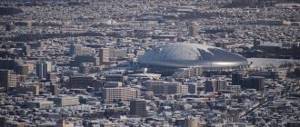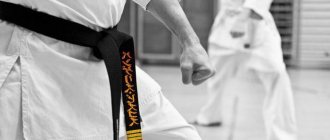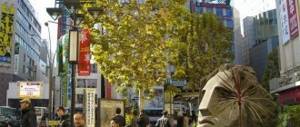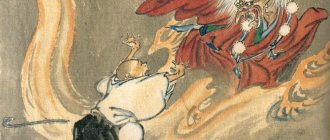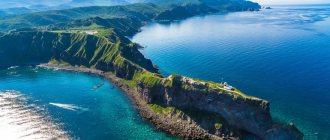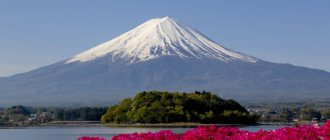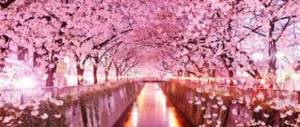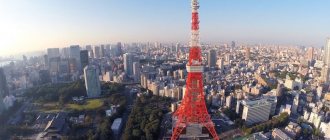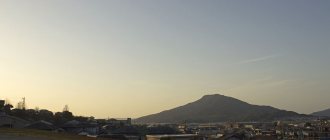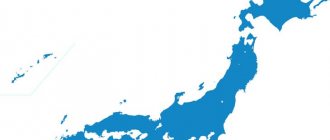Honshu - main resorts and areas, excursions and attractions, museums, tourist reviews about Honshu.
- New Year tours
around the world - Last minute tours
around the world
Home to exquisite ceramics, a land of quiet mountain villages and bustling metropolises, Western Honshu is infamous throughout the world for the atomic bombing of Hiroshima. But time heals the wounds of the past, and the current island of Honshu can offer tourists a lot of interesting things. For example, Okayama and Hiroshima prefectures have charming coastal areas - Kurashiki, with excellent museums, and Bizen, famous for its pottery and weapon smiths. Yamaguchi Prefecture is famous for its limestone caves, and Shimonoseki offers fresh seafood, especially fugu fish, which is considered a special delicacy in Japan.
A little geography
As mentioned, Honshu Island is one of the four main islands of Japan and is the largest in the archipelago. Its area is about 228 thousand km2, and its length is more than 1300 km. These indicators indicate that Honshu occupies more than 60% of the entire territory of Japan. For comparison, imagine that the Japanese island of Honshu is not much smaller than the well-known UK.
The location of Honshu is unique in itself, as it is located on the border of tectonic plates. It is of volcanic origin and is washed from the west by the Sea of Japan, from the east by the Pacific Ocean, and from the south by the Inland Sea of Japan. This position of the island of Honshu creates a varied climate. In the north it is temperate, and in the south it is subtropical. The proximity of the ocean causes monsoon rains, the bulk of which occur in June and July.
Turn on idle mode
Okinawa Island, Ryukyu Archipelago
See how to get to Okinawa cheaper by clicking on the photo!
Ask any Japanese where to take the perfect vacation, and they will immediately blurt out “Okinawa!” The southern archipelago is loved for its snow-white beaches, palm groves and turquoise water. Choose one of the islands scattered in the warm sea - from April to October it is comfortable everywhere.
On Taketomi, where instead of taxis they ride buffaloes, it’s good to escape from civilization. Snorkelers will love Ishigaki, where coral forests grow just meters from the shore and colorful parrotfish glide by. It’s worth visiting the island of Iriomote for the dense jungle that occupies a good half of the island, and on Kuma for the natural pools in the rocks. The entire archipelago in one bottle is collected on the main island - Okinawa: there are picturesque beaches, giant whale sharks in the Churaumi Aquarium, and underground caves in the Okinawa World theme park.
Also interesting: The best beaches in China: Sanya, Hainan, Hong Kong and more
Find low-cost flights to Japan
Find a cheap hotel in Japan
Volcanoes of Honshu Island
Many volcanoes, active and extinct, are located on the territory of the island of Honshu. Because of this, it is seismically and volcanically active. The most famous volcano in Japan is Mount Fuji, 3776 meters high, located on a plain almost at sea level. This intimidating symbol of Japan is visible from 80 km away in clear weather and makes Honshu one of the ten highest islands in the world.
The beauty of extinct and 20 active volcanoes attracts many tourists. There is an opinion in the country that you must climb Mount Fuji at least once in your life. Interestingly, this mountain is considered sacred by both Shintoists and Buddhists. A temple was even built on it in 806 AD. e. Now there is a seismic station and an ancient temple on the mountain.
Interestingly, Mount Fuji is not the only volcano that attracts the attention of curious visitors. The active Osoreyama volcano is considered sacred and is directly related to Japanese mythology. Literally, the name "Osoreyama" means "mountain of fear." The fact is that the mountain really looks scary because of the yellow or red mass visible in the cracks and the fetid smell of sulfur. Also located at the top, a lake with hot springs awes tourists looking at the mountain.
Fall into the Ninja's Trap
Kansai region
Photo: m-louis.®, CC BY-NC-SA 2.0
Japanese ninjas appear out of nowhere, instantly deal with their enemies and disappear into the air again. You would never guess in real life about the traps that are crammed into their former mansion, now a museum of professional killers, in Iga-Ueno. Behind ordinary-looking lockers are hidden secret passages and revolving doors through which ninjas escaped in case of danger. Find the hiding place and go down into the dungeon, where deadly weapons are hung on the walls. It is disguised as innocent junk - spiked slippers, hole-punching forks and knives in the shape of smoking pipes.
Don't miss the spectacular show where secret fighting and jumping techniques are shown. The most dexterous can try themselves in the role of a ninja - throw a deadly shuriken star or spit poison into a balloon.
Find low-cost flights to Japan
Find a cheap hotel in Japan
Prefectures and regions of the island
Like all major states, Japan is divided into regions and prefectures. The very name of the island of Honshu speaks for itself: in Japanese “Hon” means chief, and the particle “Shu” means province. So, it turns out that Honshu is the main province of the Land of the Rising Sun. And if so, then the main cities are located on this island. Tokyo, Yokohama, Kyoto and the infamous Hiroshima today appear as modern metropolises with their own unusually ancient culture.
There are only five regions on the island. Northern - Tohoku, eastern - Kanto, central - Chubu, southern - Kansai and western - Chugoku. All of them include 34 prefectures. These are the most economically developed regions of Japan. Each of them has its own special flavor, climate and nature.
Thus, Hiroshima Prefecture is famous for its potters, excellent nature reserves and authentic caves. It is located in the western Chugoku region. And magnificent Nagoya appears to be a modern economic engine and is located in the southern region. Here you can see small towns with ancient samurai traditions.
Learn to cook proper sushi
Tokyo
Photo: , CC BY-SA 4.0
Forget about how skillfully (as you thought) you rolled the rolls in your homeland. The Tsukiji Market course will teach you how to select fresh fish from the famous Tsukiji Market in Tokyo and how to make proper sushi. You can kill two birds with one stone: before the morning master class, visit the tuna auction and watch giant carcasses go under the hammer.
For those with a sweet tooth, cooking classes on Japanese wagashi desserts are offered. Making tiny fruits and flowers from rice dough is almost a job like jewelry. Wagashi is usually served with matcha green tea, without which no tea ceremony is complete. You can learn the intricacies of Japanese tea drinking in 2-3 hours.
Don't forget to thank your sensei for an interesting master class. If you add a slight bow to the usual “arigato gozaimas” (“thank you very much”) and “tanoshikata” (“that was cool”), the Japanese will tell their grandchildren about you.
Find low-cost flights to Japan
Find a cheap hotel in Japan
Transport interchange
Interestingly, the Japanese island of Honshu is connected to three other islands using bridges and underground tunnels. This unites the regions into a single space and facilitates the fast and comfortable movement of local residents.
The islands of Honshu and Hokkaido are connected through a transport tunnel built under the Sangar Strait and called Seikan. This tunnel is the world record holder. Also, three bridges built across the Inland Sea connect Honshu and Shikoku, and communication with the island of Kyushu passes through a bridge and two tunnels. Also in the largest metropolis there is a separate metro interchange connecting different areas of the city, monorail and high-speed trains.
All these connections show how developed the country's economic system is. This is also confirmed by the bulk islands located around the main natural ones. The peculiarity of economic growth is all the more striking when you realize that for a long time Japan was an isolated state that did not allow Europeans into it.
A little history of the island
The first mention of a strong state headed by an emperor appeared in the 8th century. The capital from 710 to 784 was Nara, a city in Japan on the island of Honshu. To this day, ancient Buddhist temples have been preserved in it, as well as the famous imperial palace of Heijou and Sesoin - this is where the jewels of the imperial court are kept.
In 794, the capital was moved to the city of Heianke, today it is called Kyoto. It was here that the national culture was born and its own special language appeared. Until this time, Chinese was widespread.
The first Europeans appeared on the island in 1543, they were Dutch traders and Jesuit missionaries. Then, until 1853, trade was carried out only with China and Holland. It was only a little over 150 years ago that Japan began to negotiate with other countries of the world, such as the USA, Russia, France and Great Britain.
And it is this story that amazes the imagination, since today's achievements in the field of science and modern technology have brought Japan to one of the first places in the world.
Feel the samurai spirit
Himeji city, Kinki region, also known as Kansai
Photo: Bernard Gagnon, CC BY-SA 4.0 via
Since the times of the samurai, who were ready to immediately commit hara-kiri, a dozen authentic castles have survived in Japan. The most famous fortress, Himeji, reminds the Japanese of a graceful white heron soaring above the city. The enemy cannot approach: the castle is protected by embankments, deep ditches and loopholes in thick walls. Climb the steep stairs to the top to see a picturesque labyrinthine garden set against a backdrop of white curved roofs.
The “dark brother” of Himeji is considered to be the wooden Matsumoto Castle, or Crow Castle, in the mountainous Nagano Prefecture. It is impossible to take your eyes off the black tower wings reflected on the water surface of the pond. The inside is ascetic as a samurai, only the second floor is hung with old muskets and revolvers. And in one of the towers there are special “lunar chambers”: they were once built specifically for contemplating the Moon. The balcony still offers beautiful views on three sides at any time of the day or night.
Find cheap flights to Japan
Modern cities
The largest metropolis on the island of Honshu is its incomparable capital, Tokyo. This is a gigantic, ultra-modern city with the largest population on the planet, which amounts to more than 37 million inhabitants. Despite modern skyscrapers and a huge mass of people, the city attracts with its harmony with old Japan. There are many attractions in Tokyo, from majestic and calming temples to over 500 different museums.
The ancient capital of the Japanese state, Kyoto, is today very lively and youthful. It is here that there are many magnificent parks, a luxurious botanical garden with many pavilions and the Gose Imperial Palace, founded in 794. The city is famous for its unique rock gardens, Rean-ji and Sambo-in, and is also home to many imperial tombs.
Hiroshima is a city on the island of Honshu, infamous for its nuclear attack in 1945. The rebuilt city is today a symbol of peace. It houses the Atomic Dome, the Eternal Flame and the Memorial Park. But despite these events, Hiroshima is a major industrial center where the world famous Mazda cars are produced.
Admire the cherry blossoms
Tokyo city
To see Japanese cherry blossoms in bloom, take cheap tickets to Tokyo for spring
The Japanese have a great sense of beauty: it’s not for nothing that they have elevated admiring cherry blossoms to a special cult. You can watch fragile petals slowly swirling in the wind for only a couple of weeks a year. In mid-April, the buds bloom in Tokyo, enveloping the city in a soft pink cloud. To capture sakura on the surface of the water, take a boat ride along the flowering banks of the Sumida River or rent a boat in Chidorigafuchi Park. In Tokyo's Ueno and Eegi parks, noisy picnics do not stop until late in the evening, when the trees are illuminated with colorful lights.
At the height of cherry blossoms, the resort region of Hakone is incredibly beautiful. Be sure to take a classic shot with pink branches against the snow-white cone of Fuji.
What else to do in the capital of Japan: 8 ways to see Tokyo from different angles
Find cheap flights to Tokyo
Find a cheap hotel in Tokyo
Interesting Facts
Let's look at some interesting facts that will tell you even more about the amazing island of Honshu.
- The world famous poisonous puffer fish lives in the Pacific waters near the island of Honshu. This is where the largest specimens are caught.
- The most famous electronics company, Hitachi, got its name in honor of the city of the same name, located in Honshu.
- In 1998, the island of Honshu (Japan) was chosen to host the 18th Winter Olympic Games. They took place in the city of Nagano.
- Japan is a left-hand drive country. All Japanese cars have a steering wheel on the right side, and not on the left, as Europeans are used to. When planning to rent a car in Japan, take this fact into account so as not to create problems for yourself on the road.
- Mount Fuji is located in the Fuji-Hakone-Izu National Park, where many volcanoes are concentrated in the forest zone and Lake Azi is located, which never freezes. On the shore of this lake is the ritual gate of the Hakone Temple, called tori. Such gates are found throughout the island of Honshu.
There are many more interesting facts both about the island of Honshu itself, and about Japan and its inhabitants in general. And now a little impressions of what we saw.
The Second World War
Hiroshima
An event from which many traces can still be seen on Honshu is the Second World War. Even though there was never any fighting between Americans and Japanese on the Japanese "mainland", the war also caused great damage here. This was mainly due to the numerous barbaric bombings of the Americans. At the end of the war, major cities such as Tokyo, Osaka, Kyoto and Nara were carpet bombed daily by US Navy and Air Force heavy bombers. According to various estimates, as a result of the Allied raids (not counting Hiroshima and Nagasaki), up to 900,000 civilians were killed, more than 1.3 million were injured, 67 cities were damaged and about 5 million Japanese were left homeless.
Hiroshima and Nagasaki. CRIME AGAINST HUMANITY. 16+
The city of Hiroshima was one of two Japanese cities that were attacked by the atomic bomb. The cities of Nagasaki and Hiroshima were chosen by the Americans to be destroyed by atomic bombs because other larger cities were completely destroyed and reduced to ruins by conventional bombs. There was nothing and no one to bomb in them. Today you can still see traces of these terrible events. Many materials, photographs, other images and memories from this period have been preserved and exhibited in various museums throughout Honshu.
Reviews from tourists
Many people who have visited Japan are satisfied with the service and politeness of the Japanese, as well as the beauty of the area. Unforgettable walks around Tokyo or ancient Kyoto will leave no one indifferent. The only thing tourists should remember: in Japan, English is spoken only in hotels, airports and some large shopping centers. The majority speak only Japanese, all signs are also written in Japanese. But you should definitely visit this country; you will never regret it.
Many tourists note that the beauty of Mount Fuji fascinates and seems to tie you to itself with invisible threads. I would like to come back again.
The island of Honshu is an unforgettable trip that will be remembered for a lifetime.
Lose your voice at a sumo tournament
Tokyo city
The Japanese love for sumo knows no bounds - the entire Ryogoku quarter of Tokyo is given over to training schools and arenas where half-naked fat men wrestle. The most famous tournaments take place at Kokugikan Stadium in January, May and September. Come early in the morning and occupy the pillows that in the old days were used to throw at the loser - by lunchtime there will be nowhere for an apple to fall. After the match, you can take a photo with the wrestlers and taste the nutritious chanko soup, which they use to restore their strength.
If you don’t make it to the championship, it’s okay: inside the stadium there is a sumo museum all year round, where they display sumo wrestlers’ loincloths and portraits of famous yokozuna wrestlers.
In April, at the Sensoji Temple in Tokyo, infant competitions are held, which parents voluntarily present to sumo wrestlers. The child who cries the loudest and longest wins. This is how they strengthen their spirit in Japan.
Also interesting: The law is not written: unusual traditions and superstitions of different peoples of the world
Find low-cost flights to Japan
Find a cheap hotel in Japan
